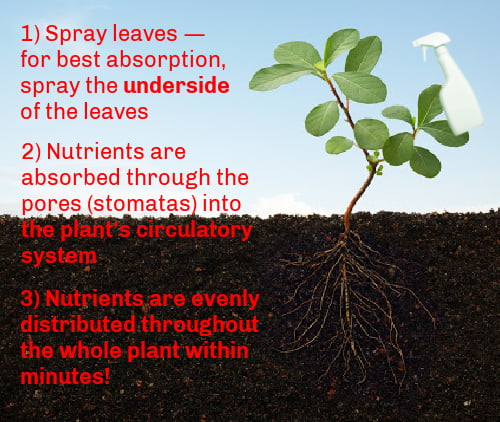The Benefits of Foliar Feeding
Why Foliar Feed?
Plants need different nutrients at different stages of development. Granular fertilizer blends applied pre-planting may or may not release the proper nutrients when they are needed. Nutrient release can be affected by soil compaction and drainage, soil bio-activity, soil temperature, dry or wet weather, and a host of other factors. By foliar (through the leaves) feeding your plants the right nutrients exactly when they are needed you can get better and more predictable results in your garden than you ever thought possible.

Since nutrients sprayed correctly on leaves are absorbed quickly and are distributed throughout the whole plant (or tree) within minutes, this means that you only have to spray some of the leaves to get nutrients to all of the plant, including the roots. This can boost plant health and production dramatically. The “law of little bits” always applies in foliar feeding: It is better to spray smaller amounts of material often rather than try to drown a plant in one large dose. So, whether you want greener grass, more flowers, more fruits or vegetables, or just more growth from a plant, foliar feeding every 7 to 10 days, or every two weeks is a great technique for serious gardeners.
One of the best products you can use for foliar feeding on all plants, trees, and grasses is our MicroNutrients.
FOLIAR FEEDING TIPS
- Spray early in the morning for best absorption and avoid mid-day heat. Early evening after the temperature has dropped is the next best time.
- Spay as much of the underside of the leaves as possible. That is where the majority of the pores (stomata) are.
- Only spray plants that have been watered regularly and are not under drought stress.
- Use a fine mist trigger sprayer, pump sprayer or commercial sprayer. Fine mist sprays give better coverage.
If you’re looking for a decent fine mist sprayer, our customers have had good luck with the Chapin, or for something smaller and sleeker, try these fine mist sprayers for beauty products, perfect for house plants (affiliate links).


